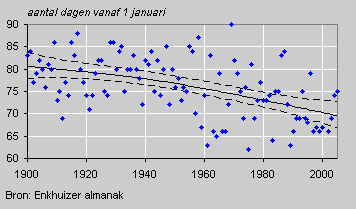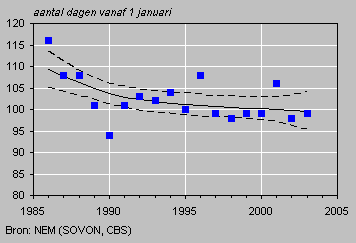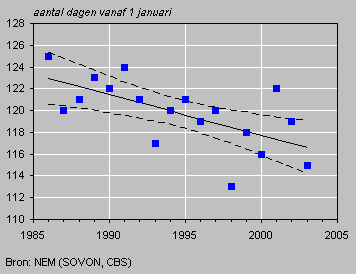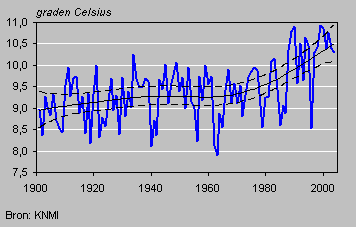Birds tend to breed earlier in the year

Nowadays the first lapwing egg of the season is tracked down approximately twelve days earlier than around 1900. It is an indication that lapwings tend to breed earlier in the spring.
Breeding season sets in earlier
Intensified fertilisation of grassland and drainage projects triggered off processes in the soil causing the grass to grow earlier and faster. As a result of premature favourable conditions, the lapwing started to hatch earlier. The first lapwing egg of the season was found earlier in the year and this process continued, presumably because the average temperature began to rise after 1970. Food and a sheltered environment for the young become available earlier in the year.
Day first lapwing egg was found

Bluetit anticipates warmer springtime
Bluetits start hatching their eggs about ten days earlier than in 1986. Insectivorous birds like the bluetit must raise their hatchlings while the food supply is abundant. The average spring temperature has risen over the past decades and as a result insects are abundant early in the year. Bluetits anticipate the warmer springs and start hatching their eggs earlier.
Mean laying date bluetit

Pied flycatcher starts breeding earlier
Compared to 1986, the pied flycatcher is laying its eggs seven days earlier. Pied flycatchers hibernate in West Africa and therefore it is difficult for them to anticipate the warmer spring and premature insect abundance. The flycatcher populations do not return sooner than they used to. On the other hand, female pied flycatchers start breeding sooner after their arrival to benefit as much as possible from the insect abundance.
Mean laying date pied flycatcher

Higher temperatures induce animal activity
The average annual temperature in the Netherlands has risen by 1.5 degrees centigrade over the past thirty years. An increase in temperature of such magnitude is likely to affect nature and to induce the invasion of non-endemic species, plants to bloom and grow prematurely and birds to lay their eggs earlier than usual. Diurnal butterflies and reptiles also appear to be active earlier in the year but time series do not date back long enough to make any valid statements on this subject.
Average annual temperature

Lodewijk van Duuren and Leo Soldaat